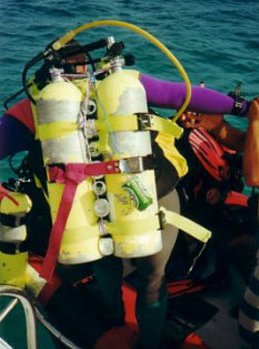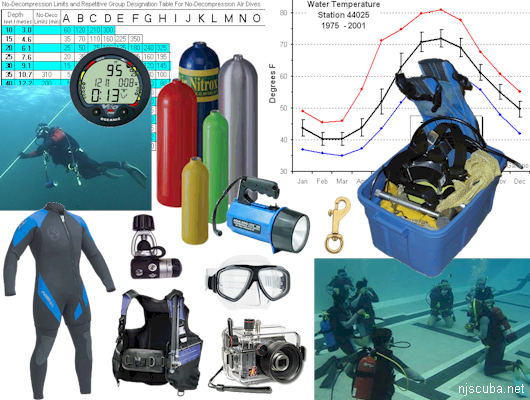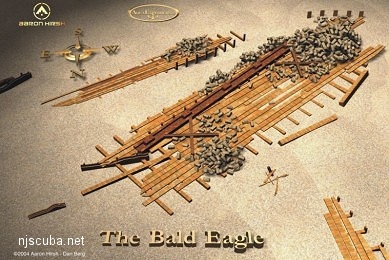Dive Gear
- The Basics ...
- Exposure Suits ...
- BC & Weight System ...
- Tanks & Hardware ...
- Regulators ...
- Navigational Aids ...
- Accessories ...
The first purchases most new divers want to make are fins, a snorkel, and a mask. The mask and the fins are necessary for diving, but while snorkeling is easy in the clear, warm, shallow waters of the Caribbean, local conditions do not favor it, as the bottom is seldom visible from the surface. None of these items should be very expensive.
2016 Update
Not much has changed in the 20 years since I first wrote this guide. These were glass, silicone, and plastic back then, and they still are. Modern stuff may be sleeker than the old models that are pictured here, but really not much has changed. I still have the first mask I ever bought, and still use it. That comes from taking good care of your gear.
More: The Basics ...
Almost all diving activities, whether in the tropics or in colder waters, will require some sort of exposure suit. For local conditions, this means either a full heavy wetsuit or a drysuit. For the tropics, there are thinner wetsuits and fabric skins, but these are never warm enough for use around here. Water temperatures in the north Atlantic vary from just above freezing at depth during the coldest part of the year to the mid-seventies at the surface during the warmest. Typically, you can expect high-fifties to low-sixties at depth even over the summer.
More: Exposure Suits ...
2016 Update
Styles and fads come and go, but the advice below remains the same for Buoyancy Compensators. Unless someone figures out how to turn them into gold, there is nothing new to say about lead weights.
These items, along with tanks, are generally considered separately, something that I think is a mistake that often leads to buying equipment that quickly becomes inadequate, especially in the rigorous environment of the North Atlantic. However, it is not difficult to select items that both perform well and allow for future expansion, once you consider the requirements and interactions. To that end, I suggest that you read both the sections on BC & weight systems, and the section on tanks.
More: BC & Weight System ...

Surprisingly, of all the devices that make up an underwater diving kit, the last to be developed was a suitable air reservoir. Demand air valves ( regulators to you and me, ) masks, fins, snorkels, weights, even drysuits may be found in the historical record up to several hundred years ago, but because of material and manufacturing requirements, the high-capacity high-pressure portable air cylinder is a relatively recent development. ( Jacques Cousteau often gets credit for something he did not invent - the demand-valve regulator predates him considerably, although he did much to perfect its application to diving. )
2016 Update
Litigation has caused manufacturers to leave the market, and be replaced by others, who then left, and then others come back. From year to year, there's no telling what brand of tanks may be available, but the specs and recommendations below should apply to any.
More: Tanks & Hardware ...
A regulator is usually among the first pieces of dive gear that a beginner will buy. Often, with a little help from your sales representative, you will be coaxed into buying much more in this department than you really need, and skimping or putting off purchases in other areas that would benefit you much more. This is a shame since much of the other gear you buy will make much more of a difference to you when you are actually in the water. Before you dismiss this statement as heresy, please consider my reasoning.
More: Regulators ...
Here are a few pieces of gear to help you find your way around in the deep blue, or green, brown, or black, as the case may be. When diving, it is important to remember that you need to navigate both horizontally, and vertically. The vertical component is usually taken care of by the dive boat anchor, but emergencies do occur, and you should be prepared.
2016 Update
Nothing much has changed in twenty years. The Tektite strobe is exactly the same, and you can still get good big dive reels, although enclosed models have disappeared. Compasses still point north, and flags are still a bother.
More: Navigational Aids ...
Here are some ideas on minor yet important details that get little consideration. These topics are especially important to gear-laden New Jersey divers; much less so to unencumbered warm water divers.
A light and a knife are the first two non-essential accessories that you should get. Actually, neither one is non-essential, and only a fool would dive around here without both. Goody bags are used to carry booty from the sea. This includes food, treasure, and a lot of rusty junk that you're going to pick up because it is there. They can also be used to carry tools down with you.
2016 Update
Knives and bags haven't changed much in twenty years, but lights sure have. That section has been re-written to reflect modern technology. Nothing else new here, except that solid brass snaps have gotten harder to find and a lot more expensive. So if you find one on the bottom, leave it there for me!
More: Accessories ...

- Home ...
- Dive Sites ...
- Artificial Reefs ...
- Marine Biology ...
More important than gear is training, and more important than training is experience. You can buy gear and training, but there is only one way to get experience.
In aviation there is a saying: "You start out with a full bag of luck, and an empty bag of experience. The trick is to fill up the bag of experience before the bag of luck runs out." The same is true for diving. Take it slow. As one of my instructors said: "There are old divers, and there are bold divers, but there are no old bold divers."
When you start out in this sport, buying your first set of dive gear can be bewildering, not to mention expensive. The sad truth is that as a newly-certified diver, the equipment you have seen and used so far is not what you should be buying for real-world use. Almost all of it - jacket-style BC, weight belt, light, snorkel, etc - is more suited to floating students in a swimming pool or quarry than real-world diving. Most scuba gear is designed for the mass market of easy, infrequent, warm water diving, and is inadequate and/or inappropriate for diving around here. With so many different models and variations of everything - how do you select the best equipment for you? In the absence of any other guide, your first impulse may be to go out and buy just the same gear you were trained in - which is almost certainly an expensive mistake.
More: Scuba Gear & Training ...

